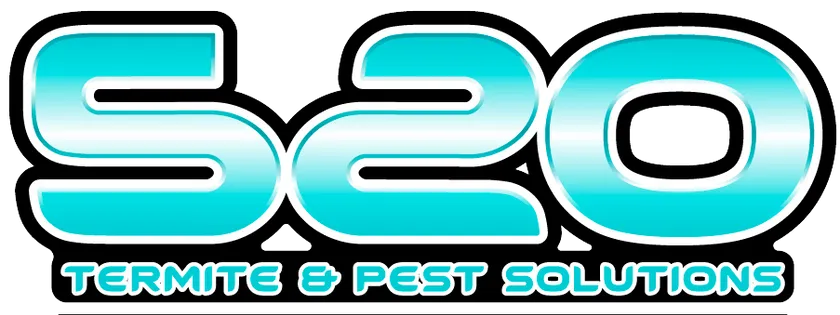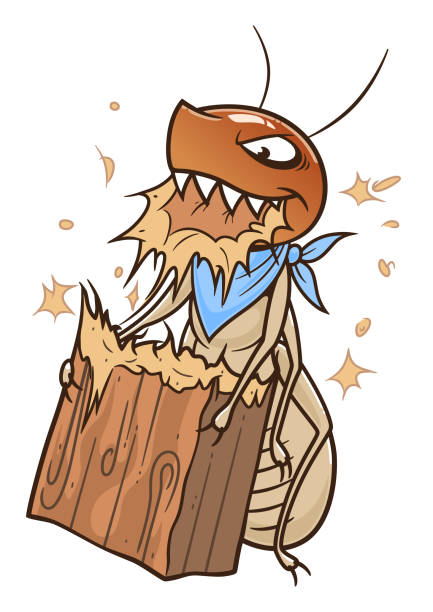
Understanding termite behavior is crucial for protecting your home and maintaining its structural integrity. Termites are more than just pests; they are silent destroyers capable of causing significant damage if left unchecked. At 520 Termite & Pest Solutions, we recognize the importance of educating homeowners about these insects. Knowledge is your first line of defense against termite infestations. By understanding their behavior, habits, and signs of their presence, you can take proactive steps to safeguard your property.
520 Termite & Pest Solutions is dedicated to providing top-tier pest control services while also empowering our clients with the information they need to prevent future infestations. We believe that an informed homeowner is a powerful ally in the fight against termites. Our commitment extends beyond mere pest control; we aim to be a trusted resource for all your termite-related concerns.
In this blog post, we will delve into the different types of termites commonly found in the areas we serve, discussing their unique behaviors, preferences, and the signs of infestation they leave behind. Our goal is to provide you with a comprehensive understanding of termite biology and ecology, which can help you recognize the importance of professional termite control. By the end of this post, you will be equipped with the knowledge needed to identify potential termite issues early and understand why professional intervention is often necessary to effectively manage and eradicate these pests. Your journey to a termite-free home begins here with 520 Termite & Pest Solutions.
The Basics of Termite Biology and Ecology
Understanding termite biology and ecology is essential for effective pest control. Termites are social insects with a highly organized caste system, which includes workers, soldiers, and reproductives. Each caste has specific roles that contribute to the colony’s survival and efficiency. Additionally, termites play a significant role in the ecosystem, primarily through their ability to decompose cellulose. However, this same ability can lead to substantial damage when they target wooden structures in homes.
Termite Biology: The Caste System
Termite colonies are structured in a way that ensures their survival and growth. The three main castes within a termite colony are:
- Workers: Workers are the most numerous caste and are responsible for the day-to-day activities of the colony. They gather food, maintain the nest, and care for the young. Despite their small size, workers have powerful mandibles that allow them to break down wood and other cellulose-based materials. Their continuous foraging and tunneling make them the primary agents of structural damage in homes.
- Soldiers: Soldiers are tasked with defending the colony from predators, primarily ants. They have large, specialized mandibles that are well-suited for combat but are incapable of feeding themselves. Soldiers rely on workers to provide them with food. Their role is crucial in ensuring the colony’s survival against external threats.
- Reproductives: This caste includes the king, queen, and alates (winged termites). The queen’s primary role is to lay eggs and ensure the colony’s growth. A mature queen can lay thousands of eggs in her lifetime. Alates are responsible for establishing new colonies. During the swarming season, they leave the nest to mate and start new colonies, which can lead to the spread of termite infestations.
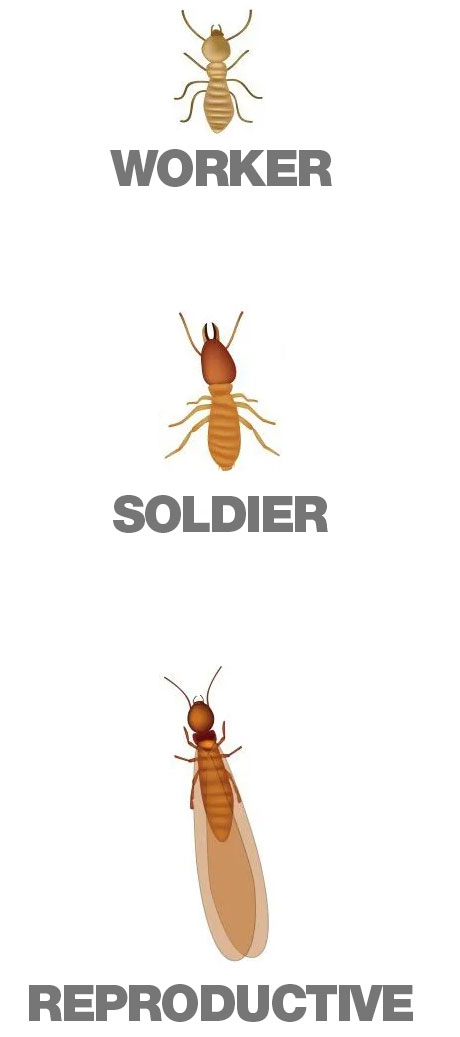
Termite Ecology and Their Role in the Ecosystem
Termites play a vital role in the ecosystem, particularly in the decomposition of cellulose, which is found in plant material. By breaking down dead wood and other plant debris, termites recycle nutrients back into the soil, promoting healthy forest growth. This process is crucial for the nutrient cycle in many ecosystems, especially tropical and subtropical forests.
In their natural habitat, termites contribute to soil aeration and help prevent the buildup of dead plant material. Their tunneling activity enhances soil structure and fertility, making them indispensable to ecological balance.
Importance of Understanding Termite Habits for Effective Pest Control
To effectively control termites, it is essential to understand their habits and behaviors. Termites are secretive creatures that often go unnoticed until significant damage has been done. Knowing their biology and ecology can help homeowners and pest control professionals take proactive measures.
- 1Early Detection: By understanding termite habits, such as their preference for moist environments and their silent, hidden activity within wood, homeowners can be more vigilant in spotting early signs of an infestation. This can include mud tubes, frass (termite droppings), and discarded wings from swarming termites.
- 2Targeted Treatments: Knowledge of the termite caste system allows for more targeted pest control strategies. For example, baiting systems can exploit the foraging behavior of worker termites, who then share the toxic bait with the rest of the colony, including the reproductives. This approach can lead to the complete eradication of the colony.
- 3Preventive Measures: Understanding the conditions that attract termites, such as excess moisture and wood-to-soil contact, can help in implementing preventive measures. Regular inspections, proper maintenance of wooden structures, and reducing moisture levels around the home can significantly lower the risk of termite infestations.
- 4Integrated Pest Management (IPM): Effective termite control often requires an integrated approach that combines chemical treatments, baiting systems, and physical barriers. By leveraging knowledge of termite biology and ecology, pest control professionals can design comprehensive IPM programs that address both current infestations and future risks.
A thorough understanding of termite biology and ecology is fundamental to effective pest control. By recognizing the different castes and their roles, as well as the ecological functions of termites, homeowners and professionals can better prevent and manage termite infestations. At 520 Termite & Pest Solutions, we are committed to using this knowledge to protect your home and ensure the safety and integrity of your property.
Types of Termites Commonly Found in Arizona
Regional Overview
Arizona’s unique geography and climate create an environment that is both picturesque and challenging for homeowners, especially when it comes to pest control. The state is characterized by its arid and semi-arid climate, with hot summers and mild winters. These conditions are ideal for certain termite species, as the heat accelerates their breeding cycles and dry wood provides ample food sources. Areas with occasional rainfall and irrigated landscapes, common in urban settings, create microenvironments that support termite activity year-round. In Arizona, the most prevalent termite species are subterranean termites, drywood termites, and dampwood termites. Each of these species has distinct characteristics and behaviors, which makes understanding their habits crucial for effective pest control.
Subterranean Termites

Description and Characteristics
Subterranean termites are the most widespread and destructive termite species in Arizona. These small, creamy-white insects live in large colonies underground, where they remain hidden from sight while causing extensive damage to homes and structures. Unlike other termite species, subterranean termites build extensive tunnel systems that allow them to access food sources above ground. Their ability to remain concealed and their relentless feeding habits make them a formidable threat to property owners in Arizona.
Subterranean termites have a complex social structure, with different roles for workers, soldiers, and reproductive members. The worker termites, which are responsible for gathering food, are the ones that directly cause damage to wooden structures. These termites are particularly drawn to cellulose-rich materials, making wood their primary target. Because they live underground, they often go unnoticed until significant damage has already been done.
Behavior and Habitat Preferences
Subterranean termites prefer moist environments and are typically found in soil, which they use to maintain the necessary humidity for their colonies. Arizona’s unique climate, with its hot summers and mild winters, provides an ideal environment for these pests. They are most active during the warmer months, but their underground nests protect them from temperature extremes, allowing them to remain active year-round.
These termites create mud tubes to travel between their nests and food sources. These tubes, which are about the width of a pencil, serve multiple purposes: they protect the termites from dehydration, predators, and environmental conditions, and they provide a safe passageway from their colony to their food. The mud tubes are often found on foundations, walls, and other structures, serving as a telltale sign of their presence.
Signs of Infestation
Recognizing the signs of a subterranean termite infestation early can save you from significant repair costs. Here are the key indicators to watch for:
Mud Tubes: One of the most common signs of subterranean termites is the presence of pencil-thin mud tubes. These tubes can be found on foundations, walls, and other parts of a building. They are used by termites to travel between their underground nests and their food sources. Breaking open a mud tube and finding live termites inside is a clear sign of an active infestation.
Swarmers: Winged termites, or swarmers, are reproductive members of the colony that emerge in large numbers to mate and establish new colonies. In Arizona, these swarming events typically occur in the spring and after a heavy rainfall. Swarmers are often seen around windows, doors, or light sources, both inside and outside the home. Finding discarded wings is also a common sign of a recent swarming event.
Damaged Wood: Subterranean termites consume wood from the inside out, often leaving a thin veneer of wood or paint on the surface, while the interior is hollowed out. Wood damaged by subterranean termites may appear blistered or layered. Tapping on the wood may produce a hollow sound, indicating that the interior has been compromised. Infested wood may also break apart easily, revealing the termites and their tunnels inside.
At 520 Termite & Pest Solutions, we understand the challenges posed by subterranean termites in Arizona. Our experienced team is equipped with the latest tools and techniques to detect and eliminate these destructive pests. If you suspect a termite infestation, contact us immediately for a thorough inspection and effective treatment plan to protect your home from further damage.
Drywood Termites
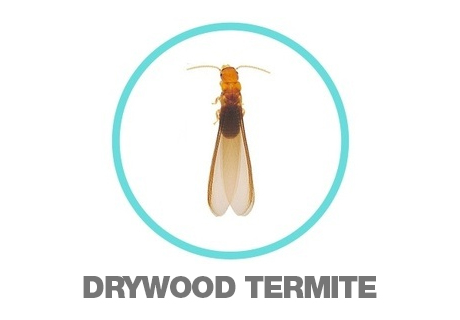
Description and Characteristics
Drywood termites are a significant threat to homes and structures in Arizona, despite being less widespread than their subterranean counterparts. Unlike subterranean termites, drywood termites are larger and do not require contact with soil to thrive. They infest dry wood, such as wooden structures in homes, furniture, and hardwood floors. These termites have a distinctive appearance, with a darker, more robust body compared to the creamy-white subterranean termites.
Drywood termite colonies are typically smaller than those of subterranean termites, but they can still cause substantial damage over time. Their ability to live entirely within the wood they consume makes them particularly insidious, as they often go unnoticed until significant damage has occurred. These termites can survive with minimal moisture, drawing the necessary water from the wood they infest, which makes Arizona’s arid climate no deterrent to their destructive behavior.
Behavior and Habitat Preferences
Drywood termites have a unique set of habitat preferences and behaviors that distinguish them from other termite species. They prefer dry, undecayed wood and can infest various wooden structures within a home. This includes structural beams, furniture, hardwood floors, and even picture frames. Unlike subterranean termites, drywood termites do not build mud tubes. Instead, they create their colonies within the wood, making detection more challenging.
These termites are often found in attics, wooden beams, and furniture. Their colonies can remain hidden for years, slowly consuming the wood from the inside out. Because they do not need soil contact, drywood termites can establish multiple colonies within the same structure, further complicating eradication efforts. The absence of mud tubes means that traditional signs of termite infestation, such as visible tubes on foundations, are not present, making other signs of infestation critical to recognize.
Signs of Infestation
Detecting a drywood termite infestation early can prevent extensive damage to your home. Here are the key signs to look for:
Fecal Pellets: One of the most distinctive signs of a drywood termite infestation is the presence of hard, six-sided fecal pellets, also known as frass. These pellets are expelled from the wood and accumulate near infested areas. They are often found in small piles resembling sawdust or coffee grounds, indicating active termite activity.
Blistered Wood: Infested wood may appear blistered or layered, a result of the termites hollowing out the interior. The surface of the wood may remain intact while the inside is riddled with galleries. This damage can cause the wood to break easily, revealing the intricate tunnel systems created by the termites. Blistered or layered wood is a clear sign that drywood termites have taken up residence.
Swarmers: Like subterranean termites, drywood termites produce swarmers, which are winged reproductive members of the colony. These swarmers leave the colony to mate and establish new infestations. Swarming typically occurs during specific times of the year, often after rain or during warm weather. Swarmers are attracted to light, so they are commonly seen around windows, light fixtures, and other light sources. Finding discarded wings is also a common indication of a swarming event.
Dampwood Termites
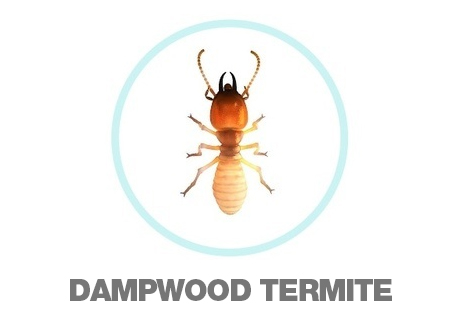
Description and Characteristics
Dampwood termites, though less common in Arizona than subterranean and drywood termites, can still pose a significant threat to homes and structures, especially in areas with high moisture content. These termites are notably larger than both subterranean and drywood termites, with a darker and more robust body. Their size and appearance make them easier to identify upon inspection.
These termites typically infest areas with high moisture content, such as wood near leaks or in damp, decaying conditions. They thrive in these environments, which provide the necessary moisture for their colonies. While they are not as prevalent in Arizona due to the state’s generally arid climate, they can still be found in localized areas where moisture accumulates, posing a risk to wooden structures that are exposed to these conditions.
Behavior and Habitat Preferences
Dampwood termites have specific habitat preferences that differentiate them from other termite species. They thrive in moist environments and are often found in decaying wood that is in contact with the ground. This includes areas near plumbing leaks, basements, or any part of a structure that experiences consistent moisture exposure. Unlike subterranean termites, dampwood termites do not build mud tubes because their moisture needs are directly met by the wood they infest.
Thy prefer wood with a high moisture content, often targeting damp, decaying wood that is already compromised by water damage. They are less likely to infest dry, intact wood, making them more of a concern in areas prone to moisture issues. In Arizona, this means that homes with poor drainage, leaky pipes, or inadequate waterproofing are more susceptible to dampwood termite infestations.
Signs of Infestation
Detecting a dampwood termite infestation early can help prevent extensive damage to your home. Here are the key signs to look for:
Presence of Damp Wood: The most telling sign of a dampwood termite infestation is the presence of damp or decaying wood. This wood is often found in basements, areas with plumbing leaks, or any other part of the home that experiences high moisture levels. Regularly inspecting these areas for signs of moisture can help identify potential infestations before they become severe.
Wood Galleries: Dampwood termites create large, smooth galleries within the wood they infest. Unlike subterranean termites, these galleries are clean and free of mud, as the termites do not need to create protective tunnels. The wood may appear hollowed out, with smooth walls inside the galleries. This type of damage can significantly weaken the structural integrity of the affected wood.
Larger Size: One of the distinguishing features of dampwood termites is their larger size compared to other termite species. Adult dampwood termites are noticeably bigger, making their presence easier to detect during an inspection. If you observe larger termites in areas with high moisture content, it is likely that you are dealing with dampwood termites.
Understanding the different types of termites commonly found in Arizona is crucial for homeowners and pest control professionals alike. Each species has unique behaviors and signs of infestation that require tailored approaches for effective management. At 520 Termite & Pest Solutions, we specialize in identifying and treating all termite species prevalent in our region, ensuring your home remains protected from these silent destroyers. Stay informed and vigilant, and don’t hesitate to contact us for professional inspections and comprehensive termite control solutions.
Secure Your Home from Termites
Understanding termite behavior is crucial for protecting your home and maintaining its structural integrity. At 520 Termite & Pest Solutions, we recognize the importance of educating homeowners about these insects. Knowledge is your first line of defense against termite infestations. By understanding the different types of termites commonly found in Arizona and recognizing their unique behaviors and signs of infestation, homeowners can better protect their properties. From the widespread and destructive subterranean termites to the insidious drywood termites and moisture-loving dampwood termites, each species requires a tailored approach for effective management. Our goal is to provide you with a comprehensive understanding of termite biology and ecology, equipping you with the knowledge needed to identify potential termite issues early and understand why professional intervention is often necessary.
At 520 Termite & Pest Solutions, we specialize in identifying and treating all termite species prevalent in Arizona. We use detailed inspections, tailored treatment plans, and ongoing monitoring to ensure your home remains protected from these silent destroyers. Don’t wait until it’s too late—your journey to a termite-free home begins with us. Stay informed, stay vigilant, and contact us today for professional inspections and comprehensive termite control solutions.
